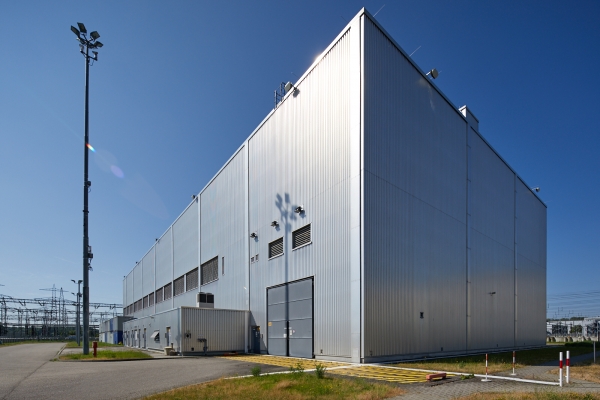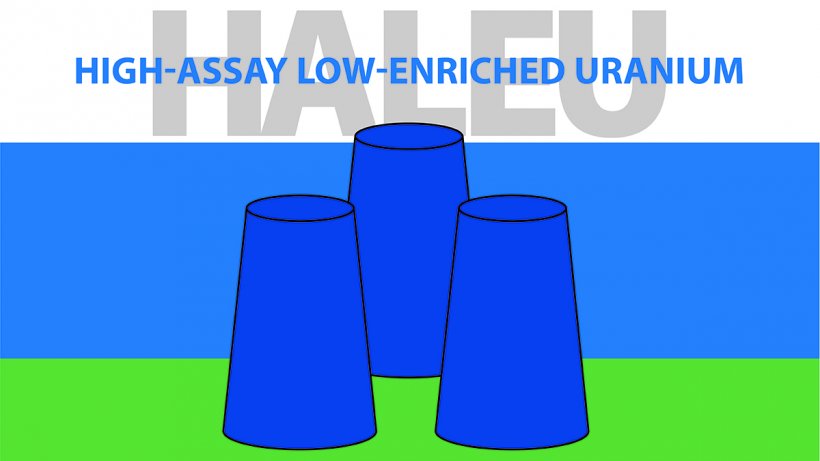The Olkiluoto nuclear power plant in Finland. (Photo: TVO)
The European Investment Bank recently announced that it is providing €90 million ($103.8 million) in financing to Finnish nuclear power company Teollisuuden Voima Oyj (TVO). The funding is to be used by TVO to support new upgrades and maintenance at the Olkiluoto nuclear power plant.
Centrus employees maneuver a cylinder at the American Centrifuge Plant in Piketon, Ohio. (Photo: Centrus Energy)
Centrus Energy announced a plan yesterday to add 300 new jobs at Centrus’s uranium enrichment plant in Piketon, Ohio, “in advance of federal funding decisions.” The company envisions adding capacity for both low-enriched uranium and high-assay low-enriched uranium production at its American Centrifuge Plant, but the “size and scope” of public and private investment is “subject to being selected for funding by the U.S. Department of Energy.”
Orano USA CEO Jean-Luc Palayer (middle) shakes hands with Zeno Power’s cofounder and CEO Tyler Bernstein (left) and Chief Commercialization Officer Harsh Desai. (Photo: Orano USA)
Zeno Power, a developer of nuclear batteries, is to receive americium-241 recovered from Orano’s La Hague nuclear fuel recycling site in Normandy, France, under a strategic agreement announced by the companies on September 24.
An aerial perspective of the 32-acre parcel OREM recently transferred at the ETTP. (Photo: DOE)
The Department of Energy’s Oak Ridge Office of Environmental Management recently completed the transfer of a 32-acre parcel at the East Tennessee Technology Park (ETTP) for private sector use. The transfer brings the total amount of property transferred from federal ownership for economic reuse to 1,832 acres at the ETTP, which was once home to the Oak Ridge Gaseous Diffusion Plant.
INL’s Hot Fuel Examination Facility. (Photo: INL)
An agreement signed by the state of Idaho and the U.S. Department of Energy will open the way for a single cask of high-burnup spent nuclear fuel to be shipped from Dominion Energy’s North Anna nuclear power plant in Virgina to Idaho National Laboratory for research purposes.
Uranium hexafluoride gas containers. (Photo: DOE)
The Department of Energy announced yesterday the six companies that it has selected to supply low-enriched uranium (LEU) from new domestic enrichment sources under future contracts for up to 10 years. The contract recipients are: Centrus Energy’s American Centrifuge Operating, General Matter, Global Laser Enrichment (GLE), Laser Isotope Separation Technologies (LIS Technologies), Orano Federal Services, and Urenco USA’s Louisiana Energy Services.
The Philippsburg interim storage facility in Germany. (Photo: BGZ)
Orano completed the 13th and final rail shipment of vitrified high-level nuclear waste from France to Germany. The company announced that the four casks of vitrified HLW arrived at Germany’s intermediate storage facility at Philippsburg in the early evening of November 20.
Hanford’s Waste Treatment and Immobilization Plant, also known as the Vit Plant. (Photo: Bechtel National)
BWX Technologies announced that the Department of Energy has approved Hanford Tank Waste Operations & Closure (H2C) to begin work under a contract valued at up to $45 billion to clean up tank waste at the Hanford Site near Richland, Wash. H2C is a limited liability company made up of BWXT Technical Services Group, Amentum Environment and Energy, and Fluor Federal Services.
Tennessee officials and lawmakers joined Orano representatives to announce Orano’s selection of Oak Ridge as its preferred site for a uranium enrichment facility. (Photo: tn.gov)
On September 4, Tennessee Gov. Bill Lee announced that Orano had selected Oak Ridge as its preferred site to build a “multibillion-dollar” uranium centrifuge enrichment facility. For Tennessee, the announcement underscores Oak Ridge’s draw for nuclear technology companies. For Orano and the nuclear power community, the announcement is another sign the nation is edging closer to adding front-end nuclear fuel cycle capacity.
Stephanie Doll of WRPS poses next to the metal patch applied during the demonstration. (Photo: DOE)
The Department of Energy’s Office of Environmental Management and its contractor Washington River Protection Solutions (WRPS) recently demonstrated the use of cold spray technology as a means of refurbishing double-shell waste tanks at the Hanford Site in Washington state. The tanks store liquid radioactive and chemical waste that was created during Hanford’s plutonium production era.
The Vallecitos Nuclear Center site in northern California. (Photo: Wikimedia Commons)
By an order dated April 25, the Nuclear Regulatory Commission has approved the transfer of ownership of Vallecitos Nuclear Center from GE Hitachi Nuclear Energy to NorthStar Group Services for nuclear decontamination, decommissioning, and environmental site restoration.
















